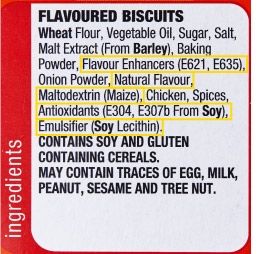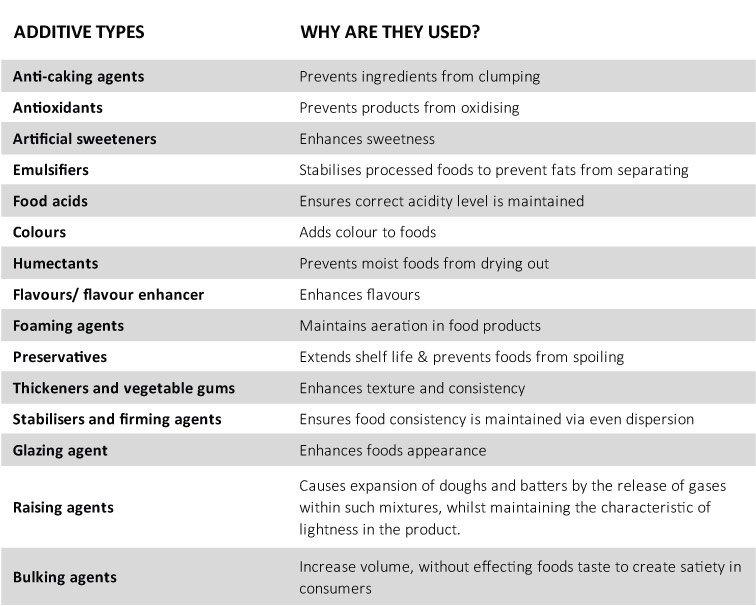
Supermarket shelves are teeming with products, and often we just grab a packet off the shelf without looking at what extra ingredients are added to our foods. Many packaged foods have additives, which can be either naturally or chemically derived, and with some ingredients more harmful than others.
To help us understand the most common food additives, and which ones we should avoid, we enlisted the help of Clinical Nutritionist and foodie friend, Rose Fenasse, (BHSc).
WHAT ARE FOOD ADDITIVES?
Food additives – the land of the unknown for many. Why do we have them? What do they do to us? Are they safe? Sit back, grab a snack and let's uncover the truth about additives.
Food additives are used to add to foods to ensure that freshness, texture, colours and other characteristics are maintained up to consumer standards. Not all additives are synthetic - some are found naturally such as the antioxidant vitamin C or ascorbic acid (300) in fruit (BetterHealth, 2012) and can have multiple uses.
Some common additives are listed below:
WHAT STANDARDS ARE THERE AROUND ADDITIVES?

In Australia, all food additives are subject to safety standards and assessment which involves thorough testing through Food Standards Australia New Zealand (FSANZ). The approved additives are tested in complete isolation, however, what we do not know are the long-term effects or consequences of consuming these additives together (FSANZ, 2016).
Product ingredient lists are written in order of predominance, with the ingredients used in the greatest amount listed first and down to the least. The additives must be listed according to their functional class name or number, which describes what the additive is and its purpose. i.e: food acid might be shown as acidity regulator (260); cochineal might be shown as Colouring (120); sodium sulphite might be listed as Preservative (221) (BetterHealth, 2012).
HARMFUL ADDITIVES AND THEIR EFFECTS
Some sensitivities or adverse reactions that stem from synthetic or natural food additives (or as a result of a combination of additives) include:
- digestive upsets
- skin reactions (such as hives, rashes etc)
- respiratory reactions (such as breathing difficulties)
Food additives that we consume day-in, day-out can be naturally occurring such as MSG, which is often used to enhance flavour. We naturally find MSG in foods such as parmesan cheese, sardines and tomato. It is important to notice not only if you are reacting to packaged foods that contain food additives, but potentially their natural ‘whole food’ derivatives – if you do notice abnormal reactions after consuming foods consult a health professional to investigate (BetterHealth, 2012).
TIP: avoid numbers and long complicated words – if you do not recognise something, it may be best to avoid it altogether.

HOW TO AVOID ADDITIVES
Ingredient lists are a mission; there are numbers that don’t add up, words that we can’t pronounce, colours that don’t belong and when we pair that with an "I don’t know what I’m looking for" mentality and it is a recipe for complete shopping sabotage.
TOP TIPS TO REMEMBER:
- Fewer ingredients are beneficial – the best quality, healthiest products are made from fewer and real whole foods.
- Remember to recognise and identify real ingredients in the list – eg. if you're shopping for strawberry yoghurt, try to find a percentage of actual strawberries in the ingredient list.
- The ingredients list is represented in descending order – with the ingredients used in the greatest amount listed first and down to the least. If sugar is at the beginning, then the greatest portion of the product contains sugar.
- Identify sneaky unnatural sugars in the ingredients list by looking words that end in "ose." i.e. Sucrose (table sugar), fructose, dextrose, and maltose.
- Avoid numbers and long words that are difficult to pronounce, as well as nasty additives that do not belong. Remember: we know the safety of additives when tested in isolation, but the safety of several additives used in conjunction is unknown.
Lastly, to avoid additives it simply pays to look out for certified organic or natural products with NO NASTIES ADDED! Honest to Goodness is proud to offer products that contain NO artificial preservatives, colours, flavours or sweeteners as well as NO added sulphur or hydrogenated fats...just Real Food That Loves You Back!

References:
Additives (Food Standards Australia & New Zealand May 2016, Retrieved March 19 2019
http://www.foodstandards.gov.au/consumer/additives/additiveoverview/Pages/default.aspx
Department of Health & Human Services, State Government of Victoria, Australia - Food additives September 2012. Retrieved March 19 2019,
https://www.betterhealth.vic.gov.au/health/ConditionsAndTreatments/food-additives
Food Standards Code. (Food Standards Australia & New Zealand, 2019) Retrieved March 19 2019,
http://www.foodstandards.gov.au/code/Pages/default.aspx






